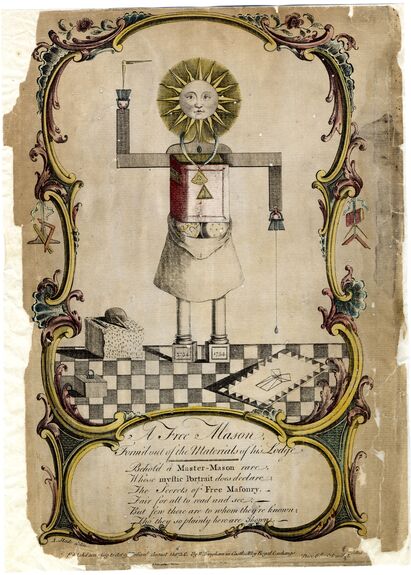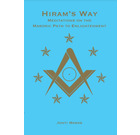So, what does a Master Mason look like?
It’s a question I keep asking myself.
How does a Master Mason move through this world of forms? How does a Master act? Speak? Think?
What, exactly, is a Master Mason a master of?
In some ways, my latest book, “Hiram’s Way” is an attempt to answer all these questions and an exploration of the idea of Mastership in a more esoteric spiritual way: not mastership of a physical art, necessarily (although, of course, that’s what we might expect from a definition of an Operative Master Mason.) No, my questions wanted a deeper answer, a more personal, introspective answer; an answer that saw Mastership, not as external power and control but completely within the context of an inner achievement; an inner path to becoming all that we can be. It the Mastership of Confucius, of the Buddha and, perhaps, of Hiram Abiff who left a legacy for we Freemasons that demonstrates for us, without doubt, that an honourable death is nothing to be feared compared to the horrors of a dishonourable life
Which is all very well. But what does a Master Mason look like?
Perhaps we all have different ideas of what a perfect human is and can be, but all our religions and philosophies, all our gurus and self-help books suggest that kindness, love, tolerance, empathy, generosity and faith are some of the marks by which a self-realised soul may be known.
So are these the qualities of a Master Mason?
A look at our ritual, our lectures, our Ancient Charges all seem to suggest that, yes, they are.
If we were to look for a pictorial and symbolic representation of what a Master Mason looks like, we might go, for example, to the famous wood-cut of 1754, showing “A Freemason form’d out of the materials of his Lodge.” We might also - as Freemasons are wont to do - ponder for a while on what this picture might have to teach us, and to what extent it might help to answer our question: “What does a Master Mason look like.

First of all, our symbolic Master Mason stands upon a chequered floor. We know that this mosaic pavement represents all the diversity of life and so the first thing we can deduce is that a Master Mason is of this world. He is not apart from it; not a hermit or a recluse; he is not a meditating sadhu in a cave or a monk lost in contemplation. No, he is in and of the world and he knows its struggles, its sufferings; its joys, its sorrows; its light and dark
Around him on the floor are certain artefacts: a rough ashlar with hammer and chisel to show, perhaps, that he has done the work necessary to perfect himself. A Lewis, discarded and unconnected, to show that, for the moment, he has moved beyond needing the strength and support that a Lewis might give him, but also acknowledging that it is within reach, still fixed to perfect stone, ready for when the need might arise.
And at his feet is a tracing board on which can be seen Euclid’s 47th proposition clearly drawn out. The symbolism here is deep and many layered, but let us choose to see it as a statement of perfection; of problems overcome and solved; of a life squared and true; a life in which the search to solve the great mysteries has given way to a deep and true understanding of how the world works.
And the Tracing Board itself? A plan fulfilled; a building raised; a Temple completed: a life dedicated to the glory of God and the upliftment of his fellows. These are the things upon which a Master Mason’s life rests. These things are his foundation.
His feet are formed of two perfect Ashlars and, again, this suggests that the attaining of Mastership is a task that requires time, effort and skill. We are told in our ritual that the perfect Ashlar represents man in the fullness of years after a lifetime spent in ‘regularity and propriety.’ And so it is with our Master Mason. It may not automatically mean that a Master Mason is always an older Brother because we have all met old souls in young bodies and young souls in old. But always, there is an element of these three things: time, effort and skill.
Our Master Mason’s legs are formed of two great pillars. They represent strength and stability and, when conjoined, as they must be within the symbolic body of our Master Mason, they signify ‘to establish.”
What can we deduce from this? That a Master Mason stands by the strength and stability of the Order. Also, that a Master Mason is himself a living of example of the strength and stability that come from a life well lived, founded on the finest principles, grounded - as he is - on a true and complete experience of life.
And it also reminds us that Masons are builders. We establish lives and relationships that are strong and stable and we are both nourished by them and nourish others through them.
The tops of the these two pillars are described in some detail in our ritual. They represent the Earth and the Heavens; they contain lily-work for purity and pomegranates for plenty; they are topped with an over-reaching symbol of unity and. It is interesting to note that these spheres form the viscera of our symbolic Mason: the root and guts of what he is; the driving engine of his life: purity, plenty, unity. We can suppose without doubt that these things are at the core of what it is to be a Master Mason.
If his viscera are the spheres that topped the pillars of the Temple, we can see that his chest - let us say his heart - is formed of the Volume of the Sacred Law. His life beats to the rhythms of its teachings and his clear understanding of the relationship between Creator and Creature is what allows him to call all men “Brother.”
His arms are squares that speak of rectitude of actions. His strength is all used up in doing what is right. They are linked, of course, to the book that is his chest, as from the teachings therein contained, he derives his guidance and his sense of how to act in the world.
His neck is the Level because he understands that all lives are equal in worth in the eyes of God. His neck also rests firmly on the VSL, because it from there that his understanding comes.
His hands are Lewises, speaking of strength and mutual aid. In his right hand are a pair of compasses to keep him in due bounds with all of humanity. In his left, a plumb-line, symbolising uprightness of life and action.
And finally, his head. His head is the sun, that ‘Grand luminary’ that “..enlightens the Earth and dispenses its blessings” to all.
The sun is everything: light, life, knowledge, power, warmth: an eternal blessing. A Master Mason is, literally, a bringer and a shiner of Light. He understands the doctrine of the Brotherhood of Man under the Fatherhood of God and he dispenses the blessings of this knowledge to all who come within his circle.
He stands at the centre of things, as does the sun, and it is within his orbit, his gravitational pull, that we are able to feel the light and love of our Creator.
It is here that the path of Freemasonry will lead us if we allow it. This is the Mastership to which our ritual points.
This is what a Master Mason
looks like:
Grounded. Centred. At peace with the world and himself.
By Jonti Marks
This article was inspired by Jonti's new book Hiram's Way



COMMENTS